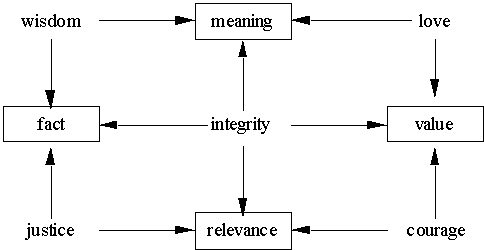
| Kolb describes the four basic creative dimensions as Meaning, Value,
Relevance and Fact. This is summarized in the diagram above. In these terms,
reframing is altering Meaning, Value, Relevance or Fact by altering context
or perspective.
|

Creative Dimensions (after Kolb) |

Hedonic framing involves a preference-based choice among
different ways of describing the same situation. It explains this choice
in terms of some pleasure/pain or other utility function.
Jon Elster indicates two possible
examples of this:
 |
People edit gambles in a way that would make the prospects appear most
pleasant (or least unpleasant) |
 |
The would-be minimizer of charitable donations compares the fairness
mechanism and the utilitarian mechanism and settles for the one that allows
him to donate as little as possible, consistent with his need to retain
his self-respect. |
source [Elster 1999] p 39

 |
In business, every cheap huckster salesman uses reframing (and visualization)
when he says "Picture yourself owning this, the envy of your neighbours."
In other words, the goal is no longer merely to cut the grass efficiently. |
 |
How does the ‘visionary’ leader impart her strategic vision to the
organization? |
 |
Giving a new value to a product by finding a new market/context. |
 |
Changing the mission statement (transport, not railroads). |
 |
A certain computer manufacturer [IBM] would have been vulnerable to
accusations of monopoly power (leading to trust-busting measures) had it
announced its dominant share of the computer mainframe market. Instead,
it claimed a smaller share of the total office equipment market. (Note:
the sequel.) |

Neuro-Linguistic Programming was developed by Richard
Bandler and John Grinder, based largely on the therapeutic practices of
Milton Erikson and Virginia Satir. There are strong links to the
thinking of Gregory Bateson
and his associates (which included Haley and Watzlawick).
NLP operates at several logical levels: as a therapy or self-therapy
practice (for which training courses and popular books are widely available)
and as a modelling process.
Bandler & Grinder identify two forms of reframing: meaning and context.
Context
reframing takes an undesired attribute and finds a different situation
where it would be valuable. In meaning reframing, you take an undesired
attribute and find a description where the attribute takes on a positive
value.
Reframing - Virginia Satir
A classic example of a reframe by Virginia Satir concerns a father who
complains at the stubbornness of his daughter. This results in a double
reframe, in which Satir points out two things to the father:
-
There are situations where she will need stubbornness, to protect herself
or achieve something. Reframing switches to a context that makes the stubbornness
relevant.
-
It is from the father himself that she has learned to be stubborn. By forcing
the father to equate his own stubbornness with hers, this creates a context
in which he either has to recognize the value of her stubbornness,
or deny the value of his own.
Reframing - Milton Erikson
One of the common challenges of family therapy is to help the parents to
let their children go. Independence is of course a negative goal. The parents
have to gradually stop supporting their children, and the children have
to gradually stop relying on their parents.
Milton Erikson often used the approach of creating an alternative goal
for the parents: of preparing themselves to be grandparents. In a typical
case, a young woman consulted him; her parents had used their life savings
to build an extension to their house, where she was to live, when she got
married (At this time, she was away at college, and had no steady boyfriend.)
Erikson met the parents, and congratulated them for their willingness to
participate so actively in the rearing of their (hypothetical) grandchildren,
having babies crying through the night, toddlers crawling through the living
rooms, toys strewn across the house, babysitting. He thus created a powerful
positive image of the joys of grandparenthood; yet for some reason, the
couple decided to rent the extra rooms out to mature lodgers instead, and
save the money to support their grandchildren’s education. When the daughter
subsequently got married, she lived in a city some distance away with husband
and baby, and the grandparents visited frequently, but not too frequently.
Why does this example count as reframing, rather than replacement? The
alternative goal created by Erikson was not an alternative activity for
the parents; it was an alternative description of the same activity. This
alternative description enabled the parents to rethink their goals for
themselves.

| Richard Bandler & John Grinder, Reframing: NLP and the transformation
of meaning (Moab Utah: Real People Press, 1982) |
| Jay Haley, Uncommon Therapy: The psychiatric techniques of Milton
H Erikson MD (2nd ed, New York: W.W.Norton, 1986) |
| Richard Normann, Reframing Business (2001) |
 |
Several books offer reframing on a single topic. I found all these
on Amazon.
-
Business, Organizational Culture, Organizations
-
Conflict, Debate, Deforestation, International Development
-
Abstract Expressionism, Culture, Japanese Cinema, Realism
-
Consciousness, Religious Life
-
Education, Educational Policy, The Early Childhood Curriculum
-
Health, Women's Health, Resistance, The Body, The Boundaries of Sex
-
The Frame of Reason, The Rules of Competition
-
St Paul, Rembrandt
-
America, The Renaissance, The Sun
One book offers a package deal in reframing: Religion, Culture, Education,
Sexuality, Class, Race, Politics, and the Economy. Whew! |

 |
veryard projects
> change > reframe |
Last updated on November 5th, 2003
Copyright © 2002-3 Veryard Projects Ltd
http://www.veryard.com/demcha/reframe.htm
|









![]()
